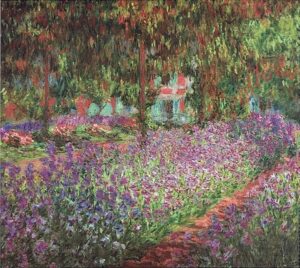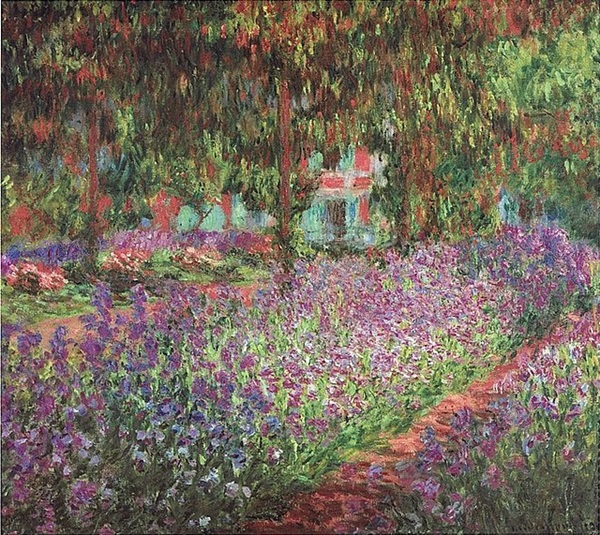
“My garden is slow work, pursued by love.”— Claude Monet
Paris had been cold. Dark figures in coats and scarves filled the street. But the day we set off for Giverny to see the gardens and home of Claude Monet, magic, color, and spring arrived.
Even as I traveled by train the 40 miles from Paris to the village of Vernon, near Giverny, and talked with my two friends, tears began to fill my eyes. Something about this trip, this excursion into beauty was touching me in an unexpected way — as if my heart were about to open.
This can’t be real, I thought. A lifetime of seeing Monet’s images in high and low places — and a few actual Monet paintings in museums, like the San Francisco Museum of Modern Art. And while in Paris I’d viewed others at the Musee D’Orsay.
I had visited homes of famous writers, and found that exciting and rewarding — to step on the floorboards in Dickens’ house, and know he probably heard the same squeak — or to gaze out the upstairs nursery window in the Bronte parsonage, and see the moors as Charlotte, Emily, and Anne did. But the idea of visiting the great Claude Monet’s garden and home — actually seeing his inspiration and creation — seemed overwhelming.
Less than an hour from Paris we were in Vernon. Just outside the train station were buses to Giverny, as well as taxis and even bicycles.
It was April, so even though several others were heading to the village, I could only imagine the huge crowds that would make the trek in summer.
Only a short few minutes ride and we were at Giverny. Walking from the bus, we passed the American Museum, full of paintings by the expatriate American Impressionists who lived and painted in Giverny before the start of World War I. They wanted to be near their hero and model, Claude Monet, and to experience the shimmering light and misty landscapes of his paintings. (In truth, Monet was not always happy with this group of followers who painted his garden and neighborhood).
Though I hoped to see this museum at some point, my interest was with the master himself. First, his home and environs. Walking through the gift shop (at one time his water lily studio) I saw the door leading to the garden. I stepped through it like Dorothy entering the Emerald City.
Spring seemed to arrive the minute I stepped into Monet’s world. If life was in color before, I’d hardly noticed. Here it felt a veil had been lifted from my eyes.
A palette of moss green, new grass green and waxen dark green mixed with pink tulips, yellow daisies, purple irises and small lavender blossoms. It shone with intensity, fresh as a dream. Colors were scattered in the flowerbeds, like splashes of paint. And, as in Monet’s paintings, there seemed to be no horizon. The garden was all around and above us.
The willows and poplars laced above, and Monet’s pink and green house filled the space to our right. Bright yellow flowering forsythia bushes filled in the middle space, while pink Busy Lizzie flowers encircled a nearby tree.
There was nowhere to look that wasn’t full of color and a reflection of light.
Later I read that Monet chose the area because of the way the surrounding hills diffused the light. I felt also like Linnea in the children’s book “Linnea in Monet’s Garden” by Cristina Bjork and Lena Anderson. The surroundings felt healing — as if no matter the pain or sadness or problem a person brought with them, being in the garden would help.
The long archway directly in front of the house defined and divided the Clos Normand garden. The green of climbing roses, not yet in bloom, covered the archway.
Here he lived with Alice Raingo Hoschede, his second wife. During the 43 years Monet was in Giverny, he used the garden as inspiration. He also painted nearby scenes — the grain stacks, the poplars along the river.
We decided to visit the lily pond. We passed gardeners off to the side, digging and planting, their high rubber boots like the ones Monet appears to wear in some photos.
We passed two flat-bottomed, blue boats, the prows seeming to kiss. These are replicas of the boat used in Monet’s day — and they are used to clear the underwater weeds from the lily pond.
A branch of the River Epte streams through the garden. At one point I saw a little boy, sailing leaves downstream as if a filmmaker had cast him.
In 1893, Monet created the water garden, surrounded by poplars and Babylon willows, where he grew and painted exotic water lilies in white, yellow and mauve. The Japanese Bridge was built shortly after the pond. In summer, wisteria blossoms arch above the graceful bridge. Lilies, rhododendron and azaleas splash their color on the bank.
From 1895 on, Monet devoted much of his final years to painting the water lilies and pond in all hours of the day.
The great artist gave the gift of his paintings and his wonderful garden to the world. And now I realized we are all more artist than we were before a visit, by seeing briefly through his eyes, by being immersed and touched by the beauty Claude Monet created.
This article was contributed by by Karen Kenyon.
Claude Monet’s home in Giverny, France. For more information visit Fondation-monet.com.







 Related Articles & Free Subscription
Related Articles & Free Subscription
Comment here